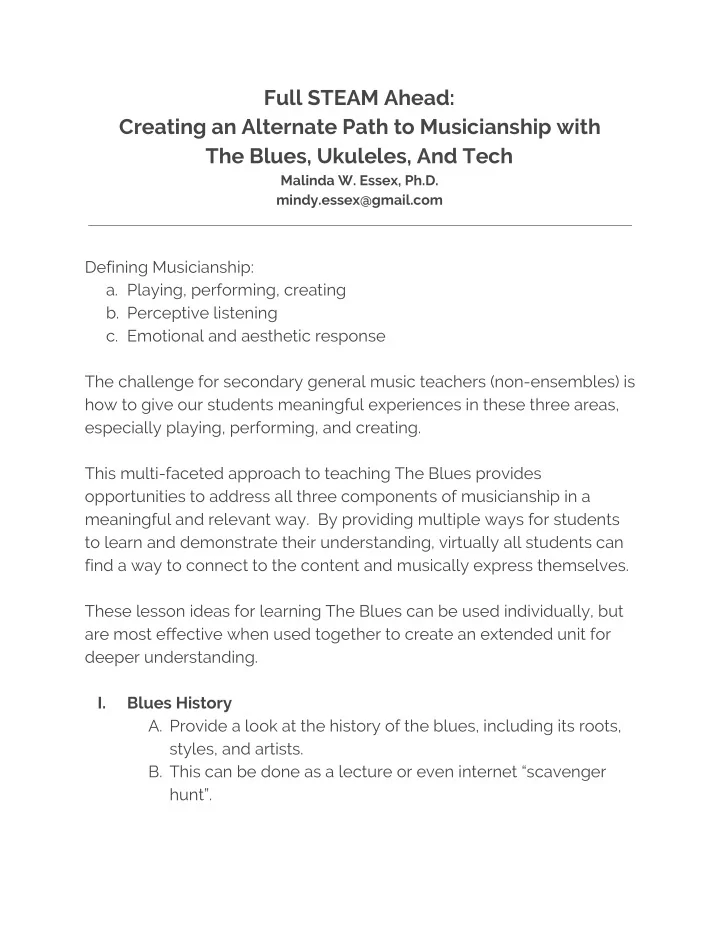

Full STEAM Ahead: Creating an Alternate Path to Musicianship with The Blues, Ukuleles, And Tech Malinda W. Essex, Ph.D. mindy.essex@gmail.com Defining Musicianship: a. Playing, performing, creating b. Perceptive listening c. Emotional and aesthetic response The challenge for secondary general music teachers (non-ensembles) is how to give our students meaningful experiences in these three areas, especially playing, performing, and creating. This multi-faceted approach to teaching The Blues provides opportunities to address all three components of musicianship in a meaningful and relevant way. By providing multiple ways for students to learn and demonstrate their understanding, virtually all students can find a way to connect to the content and musically express themselves. These lesson ideas for learning The Blues can be used individually, but are most effective when used together to create an extended unit for deeper understanding. I. Blues History A. Provide a look at the history of the blues, including its roots, styles, and artists. B. This can be done as a lecture or even internet “scavenger hunt”.
C. Check out this slide show and puzzle I use for a fun lecture format we call “Blues Brother’s Clues”. There’s even a theme song! 1. Slide Show - Blues Brother’s Clues 2. Blues Brother’s Clues Puzzle 3. Blues Brother’s Clues Puzzle Answer Key 4. Lesson Theme Song D. For older or more independent learning, here’s an Blues Internet Scavenger Hunt 1. Scavenger Hunt E. Along with introducing students to the 12 bar blues chord progression (which we dive deeper into in the next lesson) students learn the pattern followed in traditional blues lyrics and write their own. 1. Blues Lyrics Writing II. Teaching the Ukulele to beginners A. Here is a slideshow I use to introduce the ukulele and the C, F, and G7 chords to my students. Below are the steps I follow to get my students started playing the 12 bar blues. 1. Blues Intro Slideshow 2. In general, I start by teaching the C chord. As soon as everyone has this and can strum a steady beat, we start playing the blues. While looking at the 12 bar blues pattern, I use a “Blues backing track in C” on youtube (link in the slide show) and we play along with all the C chords. As classes are ready, we add the F and G7 chords. III. Writing your own Blues Tune A. Composing is perhaps the hardest portion of musicianship to address with students. Today’s technology provides great
tools for making this happen - even for students who don’t read music! B. I start with giving students a copy of the chords of the 12 bar blues progression to copy into notation software. (Two websites I’ve used for student notation are www.noteflight.com and www.flat.io . Both offer free accounts for limited use or educator accounts for more extensive use.) 1. Composing the Blues - part 1 C. After students have written the chord progression as the bass clef part, they are ready to add a melody in the treble clef. I give students the blues scale and they can use the notes in any order, any rhythm, to create a melody they like. Depending on the level of your students, you can discuss how techniques like repetition, pattern, and sequencing can make better sounding compositions. You can also suggest they follow the AAB pattern with their melody. 1. Composing the Blues - part 2 D. Composing the Blues - part 3 1. As the third part of composing, students can add a rhythm track to their composition. 2. The bass line plus the rhythm track can become a backing for students to improvise the blues on the ukulele. 3. Improvising on the blues scale is surprisingly easy on the ukulele. I usually start students improvising a rhythm on one note, then move to 2 notes, etc. Here’s a great video that shows how to use the blues scale to improv. a) Uke Blues Improv
IV. Keep going with Rock & Roll A. The great thing about teaching the blues is that they are a jumping off point for almost every other kind of American music. The easiest link is to early Rock and Roll, originally called Rhythm & Blues. Take your 12 bar blues progression, speed it up, add a “boom-chick” on the drum, and you have Rock & Roll! B. Here are some songs that use the 12 bar blues progression 1. Flip, Flop & Fly - Bill Haley & The Comets 2. Maybellene - Chuck Berry (Chorus) 3. Shake, Rattle & Roll - Bill Haley 4. Hound Dog - Elvis Presley 5. Rock Around The Clock - Bill Haley (Chorus) a) The students in my classes create their own bands of 3 to 6 people and choose one of these songs to learn and perform in our MVMS Bandstand. They use the ukulele, keyboard, and play the 12 bar blues progression (bass line on keyboard). On the drum they play a simple boom-chick … unless they are ready to stretch for something more complex. Someone in the band (or I) add the lyrics and they are ready to rock and roll!
Recommend
More recommend